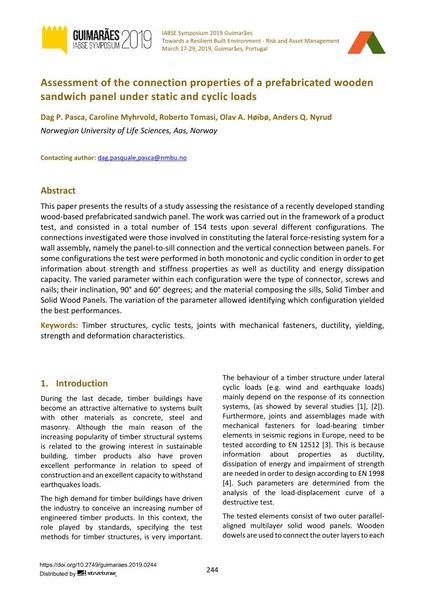Assessment of the connection properties of a prefabricated wooden sandwich panel under static and cyclic loads

|
|
|||||||||||
Bibliografische Angaben
| Autor(en): |
Dag P. Pasca
(Norwegian University of Life Sciences, Aas, Norway)
Caroline Myhrvold (Norwegian University of Life Sciences, Aas, Norway) Roberto Tomasi (Norwegian University of Life Sciences, Aas, Norway) Olav A. Høibø (Norwegian University of Life Sciences, Aas, Norway) Anders Q. Nyrud (Norwegian University of Life Sciences, Aas, Norway) |
||||
|---|---|---|---|---|---|
| Medium: | Tagungsbeitrag | ||||
| Sprache(n): | Englisch | ||||
| Tagung: | IABSE Symposium: Towards a Resilient Built Environment Risk and Asset Management, Guimarães, Portugal, 27-29 March 2019 | ||||
| Veröffentlicht in: | IABSE Symposium Guimarães 2019 | ||||
|
|||||
| Seite(n): | 244-250 | ||||
| Anzahl der Seiten (im PDF): | 7 | ||||
| DOI: | 10.2749/guimaraes.2019.0244 | ||||
| Abstrakt: |
This paper presents the results of a study assessing the resistance of a recently developed standing wood-based prefabricated sandwich panel. The work was carried out in the framework of a product test, and consisted in a total number of 154 tests upon several different configurations. The connections investigated were those involved in constituting the lateral force-resisting system for a wall assembly, namely the panel-to-sill connection and the vertical connection between panels. For some configurations the test were performed in both monotonic and cyclic condition in order to get information about strength and stiffness properties as well as ductility and energy dissipation capacity. The varied parameter within each configuration were the type of connector, screws and nails; their inclination, 90° and 60° degrees; and the material composing the sills, Solid Timber and Solid Wood Panels. The variation of the parameter allowed identifying which configuration yielded the best performances. |
||||
| Stichwörter: |
Duktilität
|
||||
